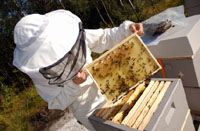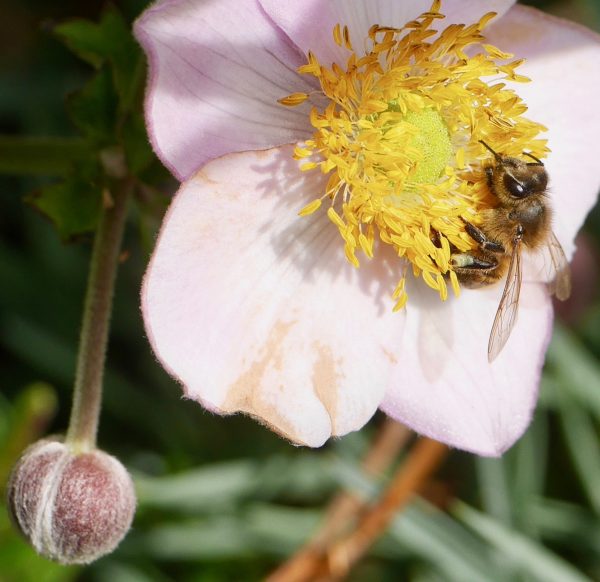Bee Friendly! – Part 3: Opening the Hive

Paul Hirons, beekeeper, continues his visit to the hive. Now the bees have been smoked and quietened down, it's time to take the top off the hive and find out what's going on ...
It’s a little bit daunting wearing a veil over your face for the first time and opening up a hive. Bees will land on the veil and you’ll think they are inside and going to sting your face. Keep calm and remember you’ve worn the bee jacket and know it well. There are no holes in it and nothing is going to get in. Stand firm and keep calm.
I undo the ratchet strap I have round the hive and its stand. I use it to secure the hive against vandals, badgers and strong winds. I remove the half a paving slab I have on the hive. I gently lift off the 4” deep tin capped roof.
I look under the roof for any earwigs or spiders that may be lurking there. I see a few earwigs so gently brush them off. I place the roof on the ground beside the hive with the top external surface on the grass. I will put the other hive boxes on top of the roof.
Once the roof is removed I see the quilt or cover board. There is a hole in the centre that fits a Porterhouse Escape. I gently put some smoke through the hole to drive any bees that are below the cover board down into the hive. They will move away from the smoke.
I can’t move the cover board so I gently insert my hive tool below its edge and twist it to break the propolis seal. The cover board then starts to move and I take it off and look underneath it. There’s a bit of comb wax on the underside which I scrape off with my hive tool. I then put the cover board in to the roof beside me.
The Honey Super
I look down onto a box roughly 18” square with eleven frames suspended on it. The frames have drawn out comb in half of them. Each frame is self-spacing using a Hoffman self-spacing system that has the side of the frame pointed on one side and flat on the other. When butted together they give me my Bee Space. The Bee Space is 3/8” and is enough space for two bees to pass back to back when on filled frames. Any wider and the gap would be filled by honey comb. I talk to them and tell them I’m only having a look. The Bees get to know your smell. They sit still and watch me. Hundreds of little black eyes looking up and each curious as to what I want. I gently smoke them before they decide to take flight and they slowly clear as they scurry down the sides of the frames.
Between the frames, are the workers looking at me? I smoke the frame gaps a bit more to drive most of them off the super frames I want to examine. I reach for my hive tool and gently prise up the lugs of the empty frames. They come away easily. There are no bees on them and I remove one frame and place it on the cover board beside me. I now have room to move the frames a bit.
I inspect each frame, working from right to left. I move Frame Ten over to Frame Eleven's position and work my way to the very left. I inspect the frames by holding them by their lugs. One lug is in my left hand and one lug in my right. I hold the frame at an angle of 45 degrees with my left hand higher than my right and inspect the side of the frame nearest to me and then by twisting the frame lugs the frame revolves and I see the other side.
I am looking for capped honey, looking for wax moth damage and looking for hive problems. These I will deal with later. Frames containing honey are quite heavy, so I keep a good grip on the lugs. If there are any bees still on the frames I’m inspecting I don’t mind; I just make sure they aren’t crushed when I put the frame back.
I see capped honeycomb on the first three frames on the left, drawn comb on Four to Seven, and Eight to Eleven are still just sheets of foundation.
I replace all the super frames and place my hive tool under the super and break the propolis seal to enable me to gently lift the super off. I place it on the roof and I usually sit it crossways so it sits on the roof edges. Some bees may fall on to the cover board below but they aren’t lost. Some may take flight but will return to the hive.
In Part 4, Paul checks the colony, looks out for the Queen and inspects the Brood Box.

Comments are closed for this post.
Discussion
now that is what i call a masterclass, thankyou for posting such a finely tuned hive of learning.

Hi,
I have opened a Beekeeping Shop at 24 Arnold Street, Arnold Street Business Park, Rugby, Cv21 3HD. The Shop is stocked with Basic Beekeeping Equipment, loads of second hand hives and a few Beekeeping Books. I work full time and the Shop is my hobby really :) I have loads of free Basic Beekeeping Info if anyone would like it. Just email me at [email protected], be pleased to send you all the files.
I would be delighted to show anyone round the Shop, by Appointment though please, and all our hives are hand made and excellent quality and best of all about two thirds the price of the major outlets. You can see the full range at http://www.beehivemaker.co.uk
I would be pleased to discuss Basic Beekeeping with anyone who is interested and be very pleased to show you the basic equipment. We have a trade Account with an Equipment Manufacturer to obtain the equipment at low prices too.
Please feel free to contact me, I’m interested in Woodlands, Canals, Boating and Sea Fishing too…..not just Bees.
Paul Hirons
Nimrod Engineering
http://www.nimrodonline.com
24 Arnold Street
Rugby CV21 3HD
Mob: 07798696388
Paul Hirons
29 April, 2010